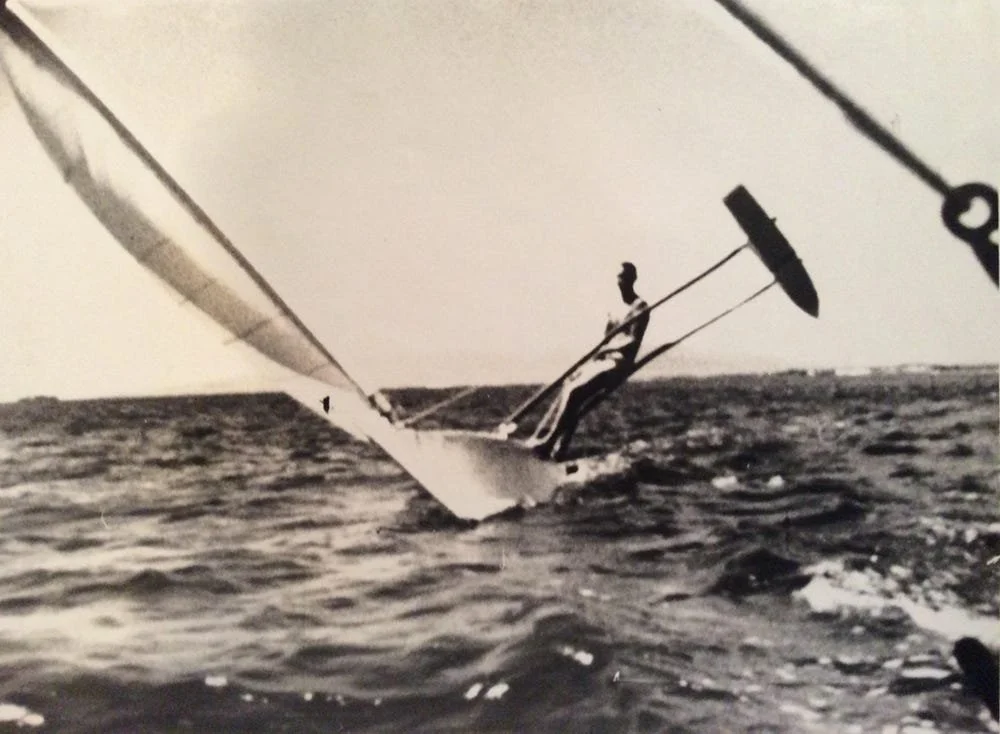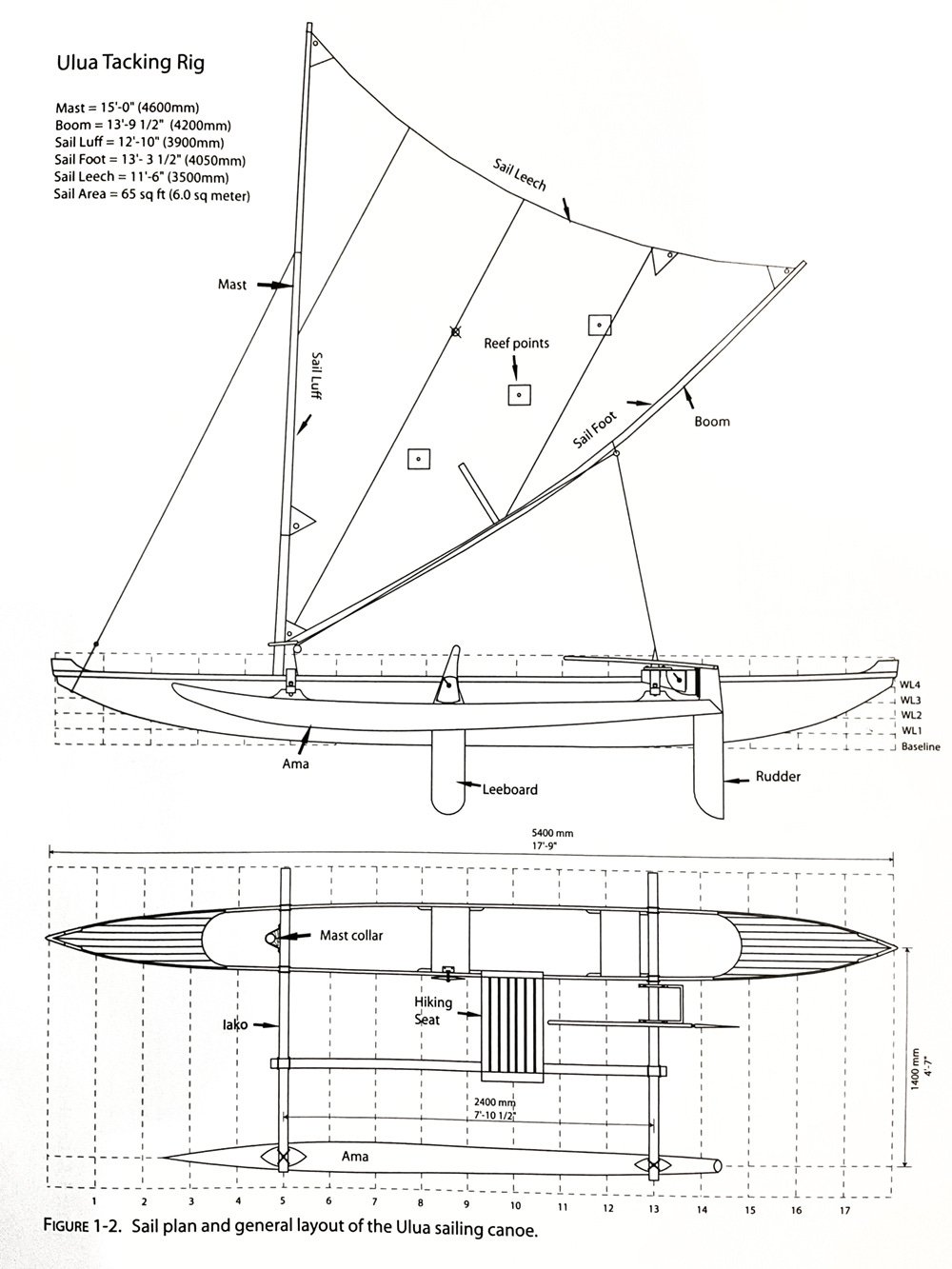Ancient History: The Malibu Outrigger and Its Ancestors
Long ago, beyond the mists of history, even before the Hobie Cat, an idea was born. It was found to be good and so it moved upon the face of the waters, at least in Southern California.
In 1950 Warren Seaman, who had been stationed in Maui during WWII, designed the Malibu Outrigger, based on similar vernacular versions of sailing canoes he had seen in Hawaii. Some were built at the Malibu Yacht Club, back in the days before Malibu became famous for affluence, celebrity and Barbra Streisand.
I have only seen a few of these boats, and none recently. They are pretty much all gone. Supposedly about 2000 were built. They were instantly attractive; different, sporty and very cool. They were unforgettable. They were 19 feet long, with 11 feet of beam; (main hull-WAA-to the outrigger-AMA). The main hull and the outrigger were connected by two slender wooden beams (IAKOs). The main hull had a simple daggerboard. They were designed to carry 192 sqft. of sail. I believe that the hull structural members were fastened with lashings to give flexible strength in the Polynesian tradition. They were lateen rigged, at least to uneducated American eyes. There was a short , unstayed mast with a flexible, curving yard (think bamboo) that was raised by a single halyard with a double purchase. The sail itself was triangular, call it lateen or crab claw.
Were the boats traditional, authentic replicas of Polynesian outrigger sailing canoes? No, they were not. But like Vivier’s contemporary designs of traditional Breton work boats (seeILLUR), Malibu outriggers captured the lines, proportions and design basics of vernacular Polynesian sailing canoes. An additional factor in their favor was that they could be sailed off the beach through the surf.
These boats in the 1950s and 60s were designed to be built by amateurs out of plywood, with a sail that could be made from a lightweight canvas painter’s drop cloth. They looked like they would be wicked fast.
They were sailed over to Catalina Island and the other Channel Islands, down the coast tp SanDiego, a few went further South to Ensenada. Simply put and even allowing for the golden glow of memory, Malibu Outriggers were “bitchen”, a 1960s term meaning “really cool”. You could build one yourself with simple tools and available materials.No fiberglass, no aluminum spars, no plastic blocks .
While not strictly traditional they were REAL! And most important for any small boat design, they were simple and beautiful.
ANCESTORS
Since writing about Malibu Outriggers almost two years ago I have often thought about why they did not become more popular. Studying the history of Oceania, especially its exploration and settlement, put me in touch with small outrigger sailing canoes as well as large double hulled “voyaging canoes” like Hokule’a.
This has led me to form a modest hypothesis: Malibu Outriggers were hot rods, and intended to be hot rods.They were fun, different, fast, jazzy and sexy_but they were not practical! They were a typical American “riff” on a known, conventional form. This form was the “typical” smaller outrigger sailing canoe, often a dugout hull, made from a single log, with a few hand cut planks used to raise the gunwale height and provide at least a partial flat deck. The outriggers were connected to the main hull by an intricate network of braces , all lashed together and often supported by short, vertical forked sticks about as thick as your wrist. The design of the Malibu Outrigger changed and simplified much of this.
To continue the hot rod metaphor, imagine another known, conventional form, a Ford Model A of the 1930s; simple, black, strong, no frills_only one windshield wiper, driver’s side. In the 1950s and 60s these were heavily “modified” into hot rods. They were chopped, given huge carburetors and lots of chrome, tuck and roll upholstery, bright colors and Von Dutch flames. No longer practical vehicles, they were best suited for street racing, impressing girls and cruising the local burger joint.
These hot rod Model As were considered to be “totally bitchen” as were the the Malibu Outriggers, their counterparts in speed, distinctive appearance and a cocky,”go to hell” attitude.But they were clearly not practical in the context of post-war America, neither of them.
In the US if you wanted to have a boat and did not live on or close to the water you needed a boat trailer. To my knowledge such “road capable” trailers did not exist for outriggers. Wait for the Hobie cat. You also needed a boat with interior, protected volume for your family, fishing rods, tackle box, picnic basket and beer cooler, not to mention an outboard motor and fuel container.
Time moved on. Hawaii grew as a tourist destination, air travel expanded and thanks to the popularity of Kon Tiki, (both the book and the movie), more Americans were exposed to Polynesian culture, even if greatly diluted and bastardized.Awareness of and interest in the “South Pacific”grew now that it was no longer a theater of war.
Private cruising yachts, mass produced using fiberglass allowed adventurous families and couples to visit, photograph and write about atolls and exotic islands; Fiji, the Marquesas, French Polynesia, the Tuamotus. One of the results of this mid-century “age of discovery”was the recognition of the continued existence and the continued daily use of traditional, vernacular outrigger sailing canoes built with local available materials. The seagoing equivalents of a Toyota Tacoma pick-up.
There are probably several contemporary boat designers/builders focused on outrigger sailing canoes; Gary Gierking, an American living in New Zealand, is on of them. I’ve never met Gary, just exchanged a few emails with him. He is most surely focused on sailing outriggers. In 2008 International Marine published his book, Building Outrigger Canoes, Modern Construction Methods for Three Fast Beautiful Boats. Duckworks now carries and sells plans for all his boats. I recommend him. His book is a complete opus on outrigger canoes in general and is much more than just a sales pitch for his own designs.His comments and advice are solid and well worth paying attention to.
It is not my intention to review Gary Dierking’s designs or suggestions. His photos and drawings speak for themselves. It is, however, my intention to report that the circle has successfully been closed from Malibu Outrigger hot rods in the 1950s to traditional, heritage-based outriggers intelligently built with modern materials in 2021. In many respects this is the best of both worlds.
Check Gary Dierking out online, get the book, pour yourself a cold one and be prepared to have your outrigger dreams come several steps closed to reality.
For traditional sailing outrigger plans see Building Outrigger Sailing Canoes by Gary Dierking.
For Malibu Outrigger plans contact Wayne L Mort Sr., 11026 Keanu Hi 96846 USA
My thanks to Pete Tresselt, Laguna Beach, CA for the photo of “Grubby “ Clark flying an AMA at Waikiki.
All opinions expressed in this piece are mine alone.
Duncan Blair


